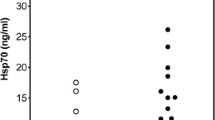Summary
In coal mines, main occupational hazard is coal-mine dust, which can cause health problem including coal workers’ pneumoconiosis and lung cancer. Some heat shock proteins (Hsps) have been reported as an acute response to a wide variety of stressful stimuli. Whether Hsps protect against chronic environmental coal-mine dust over years is unknown. It is also interesting to know that whether the expression of Hsp27 and Hsp70 proteins as a marker for exposure is associated risk of lung cancer among coal miners. We investigated the association between levels of Hsp27 and Hsp70 expression in lymphocytes and plasma and levels of coal-mine dust exposure in workplace or risk of lung cancer in 42 cancer-free non-coal miners, 99 cancer-free coal miners and 51 coal miners with lung cancer in Taiyuan city in China. The results showed that plasma Hsp27 levels were increased in coal miners compared to non-coal miners (P<0.01). Except high cumulative coal-mine dust exposure (OR=13.62, 95%CI=6.05–30.69) and amount of smoking higher than 24 pack-year (OR=2.72, 95% CI=1.37–5.42), the elevated levels of plasma Hsp70 (OR=13.00, 95% CI=5.14–32.91) and plasma Hsp27 (OR=2.97, 95% CI=1.40–6.32) and decreased expression of Hsp70 in lymphocytes (OR=2.36, 95% CI=1.05–5.31) were associated with increased risk of lung cancer. These findings suggest that plasma Hsp27 may be a potential marker for coal-mine dust exposure. And the expression of Hsp27 and Hsp70 levels in plasma and lymphocytes may be used as biomarkers for lung cancer induced by occupational coal-mine dust exposure.
Similar content being viewed by others
References
Xu Q, Willeit J, Marosi M, et al. Association of serum antibodies to heat-shock protein 65 with carotid athero sclerosis. Lancet, 1993,341(8840):255–259
Rassow J, Voos W, Pfanner N. Partner proteins determine multiple functions of Hsp70. Trends Cell Biol, 1995,5(5): 207–212
Hartl FU. Molecular chaperones in cellular protein folding. Nature, 1996,381(6583):571–579
Xu Q, Wick G. The role of heat shock proteins in protection and pathophysiology of the arterial wall. Mol Med Today, 1996,2(9):372–379
Benjamin IJ, McMillan DR. Stress (heat shock) proteins: molecular chaperones in cardiovascular biology and disease. Circ Res, 1998,83(2):117–132
Snoeckx LH, Cornelussen RN, Van Nieuwenhoven FA, et al. Heat shock proteins and cardiovascular pathophysiology. Physiol Rev, 2001,81(4):1461–1497
Pockley AG. Heat shock proteins, inflammation, and cardiovascular disease. Circulation, 2002,105(8):1012–1017
Jin X, Xiao C, Tanguay RM, et al. Correlation of lymphocyte heat shock protein 70 levels with neurologic deficits in elderly patients with cerebral infarction. Am J Med, 2004,117(6):406–411
Mandal K, Jahangiri M, Xu Q. Autoimmunity to heat shock proteins in atherosclerosis. Autoimmun Rev, 2004, 3(2):31–37
Sreedhar AS, Csermely P. Heat shock proteins in the regulation of apoptosis: new strategies in tumor therapy: a comprehensive review. Pharmacol therapeut, 2004,101(3): 227–257
Arrigo AP. Hsp27: novel regulator of intracellular redox state. IUBMB Life, 2001,52(6):303–307
Borm P, Hoehr D, Steinfartz Y. Chronic inflammation and tumor formation in rats after intratracheal instillation of high doses of coal dusts, titaniumoxides and quartz. Inhal Toxicol, 2000,12(Suppl 3):225–231
Borm PJ, Tran L. From quartz hazard to quartz risk: the coal mines revisited. Ann Occup Hyg, 2002,46(1):25–32
Hoffmann B, Jockel KH. Diesel exhaust and coal mine dust: lung cancer risk in occupational settings. Annals NY Acad Sci, 2006,1076:253–265
Kapranos N, Kominea A, Konstantinopoulos PA, et al. Expression of the 27-kDa heat shock protein (HSP27) in gastric carcinomas and adjacent normal, metaplastic, and dysplastic gastric mucosa, and its prognostic significance. J Cancer Res Clin Oncol, 2002,128(8):426–432
Cappello F, Rappa F, David S, et al. Immunohistochemical evaluation of PCNA, p53, HSP60, HSP10 and MUC-2 presence and expression in prostate carcinogenesis. Anticancer Res, 2003,23(2B):1325–1331
Barazi HO, Zhou L, Templeton NS, et al. Identification of heat shock protein 60 as a molecular mediator of alpha 3 beta 1 integrin activation. Cancer Res, 2002,62(5):1541–1548
Tang D, Khaleque MA, Jones EL, et al. Expression of heat shock proteins and heat shock protein messenger ribonucleic acid in human prostate carcinoma in vitro and in tumors in vivo. Cell Stress Chaperon, 2005,10(1):46–58
Xiao C, Chen S, Li J, et al. Association of HSP70 and genotoxic damage in lymphocytes of workers exposed to coke-oven emission. Cell Stress Chaperon, 2002,7(4): 396–402
Wu TC, Tanguay RM, Wu Y, et al. Presence of antibodies to heat stress proteins and its possible significance in workers exposed to high temperature and carbon monoxide. Biomed Environ Sci, 1996,9(4):370–379
Hightower LE. Heat shock, stress proteins, chaperones, and proteotoxicity. Cell, 1991,66(2):191–197.
Rockette HE. Cause specific mortality of coal miners. J Occup Med, 1977,19(12):795–801
Schins RP, Schilderman PA, Borm PJ. Oxidative DNA damage in peripheral blood lymphocytes of coal workers. Int Arch Occup Environ Health, 1995,67(3):153–157
Durand P, Bachelet M, Brunet F, et al. Inducibility of the 70 kD heat shock protein in peripheral blood monocytes is decreased in human acute respiratory distress syndrome and recovers over time. Am J Respir Crit Care Med, 2000, 161(1):286–292
Cai L, Zhu JD. The tumor-selective over-expression of the human Hsp70 gene is attributed to the aberrant controls at both initiation and elongation levels of transcription. Cell Res, 2003,13(2):93–109
Pockley AG. Heat shock proteins as regulators of the immune response. Lancet, 2003, 362(9382):469–476
Jolly C, Morimoto RI. Role of the heat shock response and molecular chaperones in oncogenesis and cell death. J Natl Cancer Inst, 2000,92(19):1564–1572
Bukau B, Horwich AL. The Hsp70 and Hsp60 chaperone machines. Cell, 1998,92(3):351–366
Author information
Authors and Affiliations
Corresponding author
Additional information
These authors contributed equally to this work.
Rights and permissions
About this article
Cite this article
Wang, H., Xing, J., Wang, F. et al. Expression of Hsp27 and Hsp70 in lymphocytes and plasma in healthy workers and coal miners with lung cancer. J. Huazhong Univ. Sci. Technol. [Med. Sci.] 30, 415–420 (2010). https://doi.org/10.1007/s11596-010-0441-5
Received:
Published:
Issue Date:
DOI: https://doi.org/10.1007/s11596-010-0441-5




